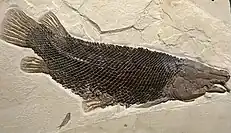Masillosteus
Masillosteus ("bony one from Messel") is an extinct genus of gar that inhabited western North America and Europe during the Eocene. It is known from two species, each from a famous freshwater lagerstätte: M. kelleri from the Messel pit in the Messel Formation of Germany, and M. janeae from Fossil Butte in the Green River Formation of Wyoming.[1][2] They are known from only a few specimens from both localities, and may have not been permanent inhabitants of the fossil lakes where they were preserved.[3][4]
| Masillosteus Temporal range: | |
|---|---|
 | |
| M. janeae specimen at the Field Museum | |
| Scientific classification | |
| Domain: | Eukaryota |
| Kingdom: | Animalia |
| Phylum: | Chordata |
| Class: | Actinopterygii |
| Order: | Lepisosteiformes |
| Family: | Lepisosteidae |
| Tribe: | †Cuneatini |
| Genus: | †Masillosteus Micklich & Kappert, 2001 |
| Species | |
| |
Masillosteus was an atypical gar with a short, broad snout and molariform teeth likely adapted to crushing crustaceans and other hard-shelled invertebrate prey.[1] It shares the short, broad snout with the extinct gar Cuneatus, which inhabited western North America during the same time period; both genera are classified in the tribe Cuneatini. Although fossils of both genera are known only from the Paleogene, it is assumed that both diverged from one another during the Cretaceous.[5]
References
- Micklich, N.; Klappert, G. (2001). "Masillosteus kelleri, a new gar (Actinopterygii, Lepisosteidae) from the middle Eocene of Grube Messel (Hessen, Germany)". Kaupia. 11: 73–81.
- Grande, Lance (2010). "An Empirical Synthetic Pattern Study of Gars (lepisosteiformes) and Closely Related Species, Based Mostly on Skeletal Anatomy. the Resurrection of Holostei". Copeia. 2010 (2A): iii–871. ISSN 0045-8511.
- Micklich, Norbert (1 December 2012). "Peculiarities of the Messel fish fauna and their palaeoecological implications: a case study". Palaeobiodiversity and Palaeoenvironments. 92 (4): 585–629. doi:10.1007/s12549-012-0106-4. ISSN 1867-1608.
- de Mazancourt, Valentin; Wappler, Torsten; Wedmann, Sonja (27 October 2022). "Exceptional preservation of internal organs in a new fossil species of freshwater shrimp (Caridea: Palaemonoidea) from the Eocene of Messel (Germany)". Scientific Reports. 12 (1): 18114. doi:10.1038/s41598-022-23125-9. ISSN 2045-2322.
- Brownstein, Chase Doran; Yang, Liandong; Friedman, Matt; Near, Thomas J. (20 December 2022). "Phylogenomics of the Ancient and Species-Depauperate Gars Tracks 150 Million Years of Continental Fragmentation in the Northern Hemisphere". Systematic Biology. 72 (1): 213–227. Retrieved 5 June 2023.